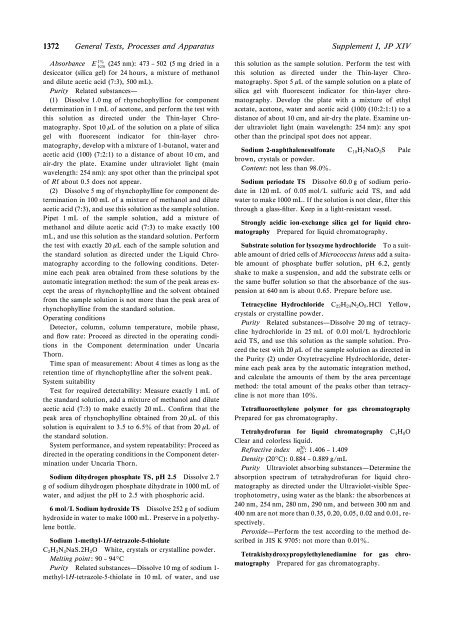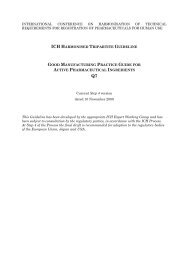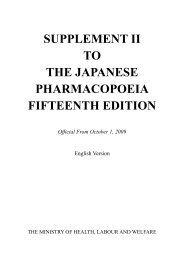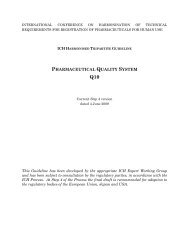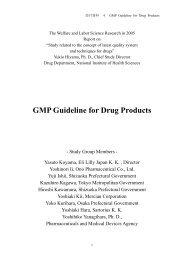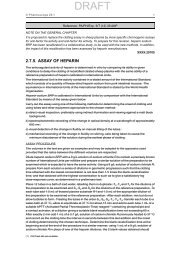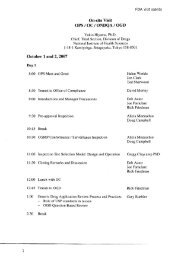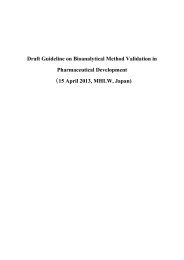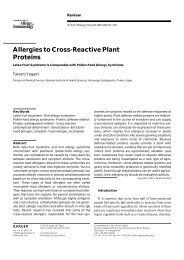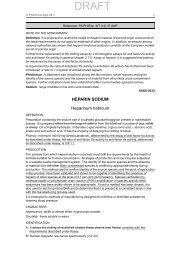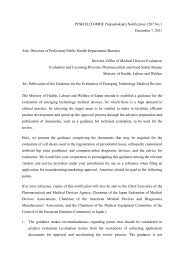Supplement I to the Japanese Pharmacopoeia Fourteenth Edition
Supplement I to the Japanese Pharmacopoeia Fourteenth Edition
Supplement I to the Japanese Pharmacopoeia Fourteenth Edition
You also want an ePaper? Increase the reach of your titles
YUMPU automatically turns print PDFs into web optimized ePapers that Google loves.
1372 General Tests, Processes and Apparatus<br />
<strong>Supplement</strong> I, JP XIV<br />
Absorbance E 1z<br />
1cm (245 nm): 473 – 502 (5 mg dried in a<br />
desicca<strong>to</strong>r (silica gel) for 24 hours, a mixture of methanol<br />
and dilute acetic acid (7:3), 500 mL).<br />
Purity Related substances—<br />
(1) Dissolve 1.0 mg of rhynchophylline for component<br />
determination in 1 mL of ace<strong>to</strong>ne, and perform <strong>the</strong> test with<br />
this solution as directed under <strong>the</strong> Thin-layer Chroma<strong>to</strong>graphy.<br />
Spot 10 mL of <strong>the</strong> solution on a plate of silica<br />
gel with ‰uorescent indica<strong>to</strong>r for thin-layer chroma<strong>to</strong>graphy,<br />
develop with a mixture of 1-butanol, water and<br />
acetic acid (100) (7:2:1) <strong>to</strong> a distance of about 10 cm, and<br />
air-dry <strong>the</strong> plate. Examine under ultraviolet light (main<br />
wavelength: 254 nm): any spot o<strong>the</strong>r than <strong>the</strong> principal spot<br />
of Rf about 0.5 does not appear.<br />
(2) Dissolve 5 mg of rhynchophylline for component determination<br />
in 100 mL of a mixture of methanol and dilute<br />
acetic acid (7:3), and use this solution as <strong>the</strong> sample solution.<br />
Pipet 1 mL of <strong>the</strong> sample solution, add a mixture of<br />
methanol and dilute acetic acid (7:3) <strong>to</strong> make exactly 100<br />
mL, and use this solution as <strong>the</strong> standard solution. Perform<br />
<strong>the</strong> test with exactly 20 mL each of <strong>the</strong> sample solution and<br />
<strong>the</strong> standard solution as directed under <strong>the</strong> Liquid Chroma<strong>to</strong>graphy<br />
according <strong>to</strong> <strong>the</strong> following conditions. Determine<br />
each peak area obtained from <strong>the</strong>se solutions by <strong>the</strong><br />
au<strong>to</strong>matic integration method: <strong>the</strong> sum of <strong>the</strong> peak areas except<br />
<strong>the</strong> areas of rhynchophylline and <strong>the</strong> solvent obtained<br />
from <strong>the</strong> sample solution is not more than <strong>the</strong> peak area of<br />
rhynchophylline from <strong>the</strong> standard solution.<br />
Operating conditions<br />
Detec<strong>to</strong>r, column, column temperature, mobile phase,<br />
and ‰ow rate: Proceed as directed in <strong>the</strong> operating conditions<br />
in <strong>the</strong> Component determination under Uncaria<br />
Thorn.<br />
Time span of measurement: About 4 times as long as <strong>the</strong><br />
retention time of rhynchophylline after <strong>the</strong> solvent peak.<br />
System suitability<br />
Test for required detectability: Measure exactly 1 mL of<br />
<strong>the</strong> standard solution, add a mixture of methanol and dilute<br />
acetic acid (7:3) <strong>to</strong> make exactly 20 mL. Conˆrm that <strong>the</strong><br />
peak area of rhynchophylline obtained from 20 mL ofthis<br />
solution is equivalent <strong>to</strong> 3.5 <strong>to</strong> 6.5z of that from 20 mL of<br />
<strong>the</strong> standard solution.<br />
System performance, and system repeatability: Proceed as<br />
directed in <strong>the</strong> operating conditions in <strong>the</strong> Component determination<br />
under Uncaria Thorn.<br />
Sodium dihydrogen phosphate TS, pH 2.5 Dissolve 2.7<br />
g of sodium dihydrogen phosphate dihydrate in 1000 mL of<br />
water, and adjust <strong>the</strong> pH <strong>to</strong> 2.5 with phosphoric acid.<br />
6 mol/L Sodium hydroxide TS Dissolve 252 g of sodium<br />
hydroxide in water <strong>to</strong> make 1000 mL. Preserve in a polyethylene<br />
bottle.<br />
Sodium 1-methyl-1H-tetrazole-5-thiolate<br />
C 2 H 3 N 4 NaS.2H 2 O White, crystals or crystalline powder.<br />
Melting point: 90–949C<br />
Purity Related substances—Dissolve 10 mg of sodium 1-<br />
methyl-1H-tetrazole-5-thiolate in 10 mL of water, and use<br />
this solution as <strong>the</strong> sample solution. Perform <strong>the</strong> test with<br />
this solution as directed under <strong>the</strong> Thin-layer Chroma<strong>to</strong>graphy.<br />
Spot 5 mL of <strong>the</strong> sample solution on a plate of<br />
silica gel with ‰uorescent indica<strong>to</strong>r for thin-layer chroma<strong>to</strong>graphy.<br />
Develop <strong>the</strong> plate with a mixture of ethyl<br />
acetate, ace<strong>to</strong>ne, water and acetic acid (100) (10:2:1:1) <strong>to</strong> a<br />
distance of about 10 cm, and air-dry <strong>the</strong> plate. Examine under<br />
ultraviolet light (main wavelength: 254 nm): any spot<br />
o<strong>the</strong>r than <strong>the</strong> principal spot does not appear.<br />
Sodium 2-naphthalenesulfonate C 10 H 7 NaO 3 S Pale<br />
brown, crystals or powder.<br />
Content: not less than 98.0z.<br />
Sodium periodate TS Dissolve 60.0 g of sodium periodate<br />
in 120 mL of 0.05 mol/L sulfuric acid TS, and add<br />
water <strong>to</strong> make 1000 mL. If <strong>the</strong> solution is not clear, ˆlter this<br />
through a glass-ˆlter. Keep in a light-resistant vessel.<br />
Strongly acidic ion-exchange silica gel for liquid chroma<strong>to</strong>graphy<br />
Prepared for liquid chroma<strong>to</strong>graphy.<br />
Substrate solution for lysozyme hydrochloride To a suitable<br />
amount of dried cells of Micrococcus luteus add a suitable<br />
amount of phosphate buŠer solution, pH 6.2, gently<br />
shake <strong>to</strong> make a suspension, and add <strong>the</strong> substrate cells or<br />
<strong>the</strong> same buŠer solution so that <strong>the</strong> absorbance of <strong>the</strong> suspension<br />
at 640 nm is about 0.65. Prepare before use.<br />
Tetracycline Hydrochloride C 22 H 24 N 2 O 8 .HCl Yellow,<br />
crystals or crystalline powder.<br />
Purity Related substances—Dissolve 20 mg of tetracycline<br />
hydrochloride in 25 mL of 0.01 mol/L hydrochloric<br />
acid TS, and use this solution as <strong>the</strong> sample solution. Proceed<br />
<strong>the</strong> test with 20 mL of <strong>the</strong> sample solution as directed in<br />
<strong>the</strong> Purity (2) under Oxytetracycline Hydrochloride, determine<br />
each peak area by <strong>the</strong> au<strong>to</strong>matic integration method,<br />
and calculate <strong>the</strong> amounts of <strong>the</strong>m by <strong>the</strong> area percentage<br />
method: <strong>the</strong> <strong>to</strong>tal amount of <strong>the</strong> peaks o<strong>the</strong>r than tetracycline<br />
is not more than 10z.<br />
Tetra‰uoroethylene polymer for gas chroma<strong>to</strong>graphy<br />
Prepared for gas chroma<strong>to</strong>graphy.<br />
Tetrahydrofuran for liquid chroma<strong>to</strong>graphy C 4 H 8 O<br />
Clear and colorless liquid.<br />
Refractive index n 20<br />
D : 1.406 – 1.409<br />
Density (209C): 0.884 – 0.889 g/mL<br />
Purity Ultraviolet absorbing substances—Determine <strong>the</strong><br />
absorption spectrum of tetrahydrofuran for liquid chroma<strong>to</strong>graphy<br />
as directed under <strong>the</strong> Ultraviolet-visible Spectropho<strong>to</strong>metry,<br />
using water as <strong>the</strong> blank: <strong>the</strong> absorbences at<br />
240 nm, 254 nm, 280 nm, 290 nm, and between 300 nm and<br />
400 nm are not more than 0.35, 0.20, 0.05, 0.02 and 0.01, respectively.<br />
Peroxide—Perform <strong>the</strong> test according <strong>to</strong> <strong>the</strong> method described<br />
in JIS K 9705: not more than 0.01z.<br />
Tetrakishydroxypropylethylenediamine for gas chroma<strong>to</strong>graphy<br />
Prepared for gas chroma<strong>to</strong>graphy.


